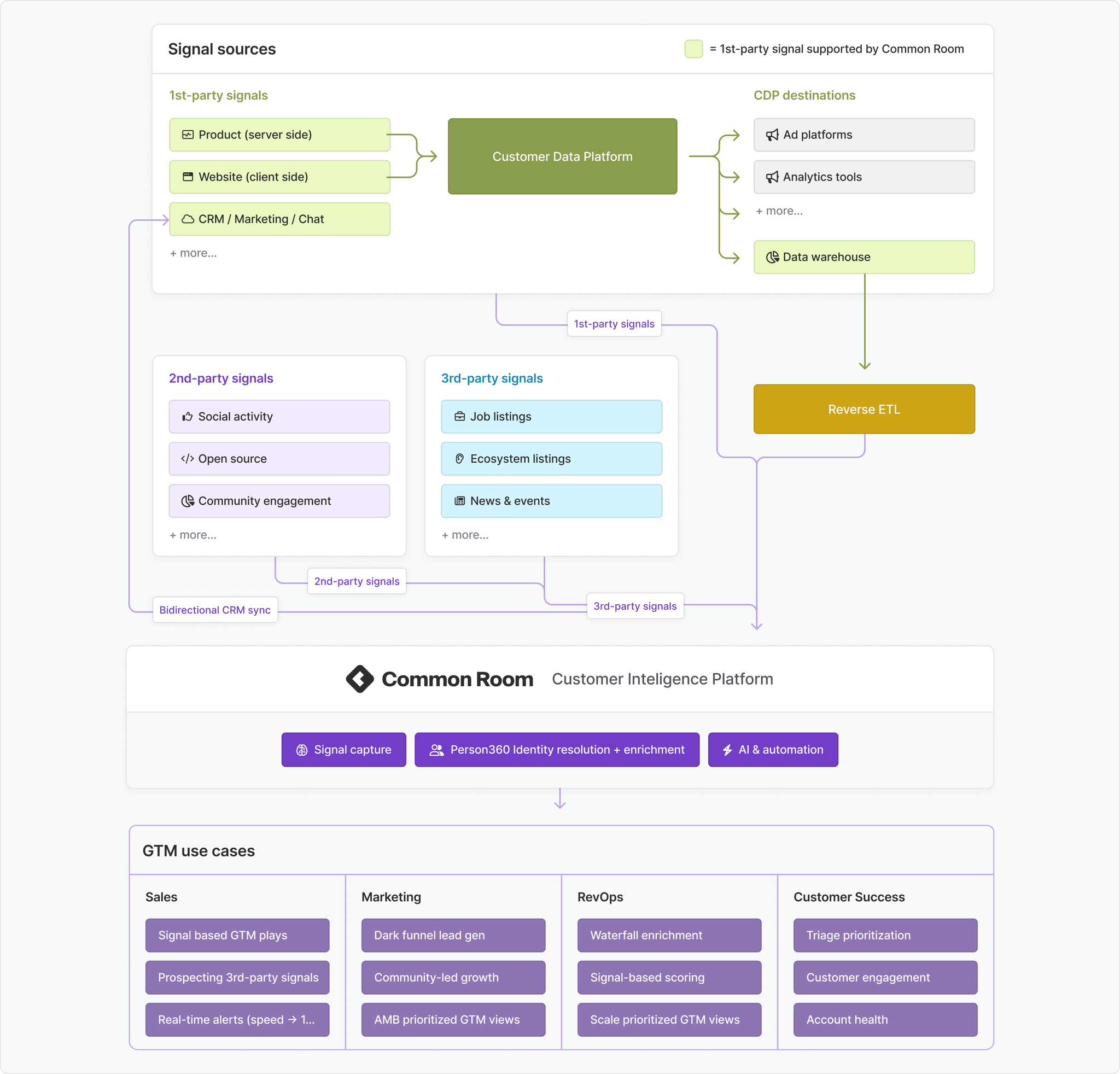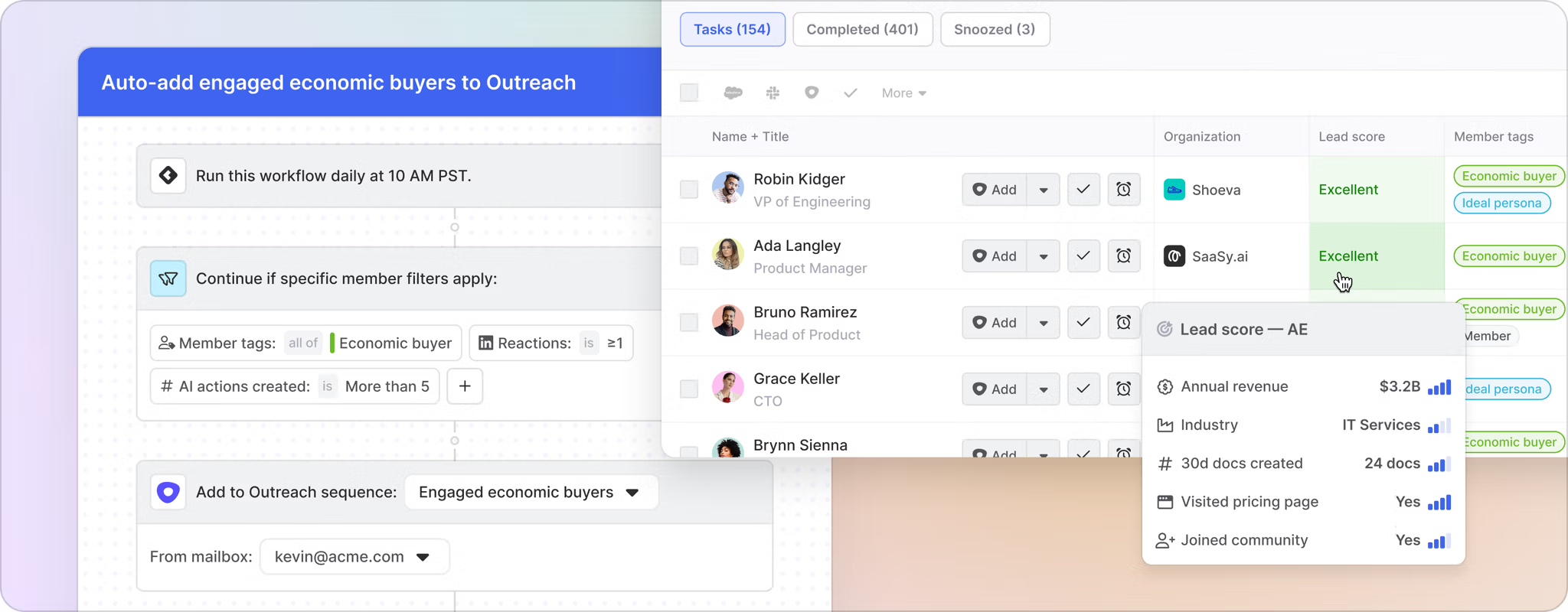- A customer data platform (CDP) is designed to help engineering and product teams track, govern, and federate first-party data (typically website and product activity) to tools where that data can then be analyzed (usually data warehouses or analytics platforms) and acted on. Think of a CDP as a fancy data bus that collects first-party data and delivers it to downstream tools.
- A customer intelligence platform (CIP) is built to help go-to-market teams unify buying signals, understand the person and account behind the signals, and take action with context—all in one place and with no engineering required. Think of a CIP as an end-to-end platform (a single pane of glass, if you will) for signal capture all the way through GTM execution.
A frequently asked question we get at Common Room: How is a customer intelligence platform (CIP) different from a customer data platform (CDP)?
It’s a fair question. They share two out of three words, after all.
Despite the name overlap, there are fundamental differences between them, from use cases to end users and everything in between.
Here’s how a CDP differs from a CIP—and why it matters.
| Customer intelligence platform | Customer data platform | |
|---|---|---|
Use cases | Sales: Workbench for signal-based plays, real-time alerts (speed to lead), prospecting account signals | Product: Analytics, A/B testing |
Ops: Waterfall enrichment, signal aggregation, signal scoring | Data eng/analytics: Data consistency & governance | |
Marketing: Dark-funnel lead gen, ABM prioritization, community-led growth | Marketing: Advertising reach and attribution, using 1st-party data from product in CRM/MAP | |
CSMs: Triage prioritization, customer engagement | ||
Implementation | RevOps/GTM leader | Engineering/Product/Analytics |
No code (to little code) required | Code required (tag management at bare minimum and client-side only) | |
Signals (CIP)/Sources (CDP) (client-side only) | 1st-party (e.g., website visits, product data, CRM) | 1st-party data only |
2nd-party (e.g., open-source activity, social interactions, support requests) | Person-level data only | |
3rd-party (e.g., job listings, news events, keyword listening) | Tracked via website (client side), server library, mobile SDK, or cloud application | |
Both person & account signals | ||
Captured via integration & authentication (no code required) | ||
Identity resolution & enrichment | Underlying model built on unified person data & account profiles | Underlying data model based on “event streams” |
Identity resolution powered by AI-matching | Identity resolution via server-side tracking | |
Waterfall enrichment out of the box | Enrichment via API call (e.g., call Clearbit API) | |
Action (CIP)/Destination (CDP) | End-to-end workflows for signal-to-play execution | Clean and standardized data |
GTM workbench reps use to burndown prioritized leads | Federates data to “destinations” where action and work takes place | |
Perform last-mile actions like adding to outbound sequence or sending a Slack message | GTM team does not have a seat or work out of a CDP | |
GTM team works out of CIP |
CDP vs. CIP: deep dive into the differences
Implementation: technical vs. non-technical
Customer data platform
CDP implementation is generally performed by an engineering or product team. The main purpose of a CDP is to capture user “events” happening across a website or within a product via API call (see Segment’s implementation spec for an example).
Events captured by a CDP are most often implemented by writing code that’s executed via API when users take certain actions, like clicking a button or viewing a screen. This is commonly referred to as a track call.
Customer intelligence platform
CIP implementation is usually handled by someone in RevOps or a GTM team leader. Connecting to most signal sources only takes a few clicks and can be done in a few minutes—no code or engineering support required. For more complex signal capture (think product data), signals are commonly synced via reverse ETL platforms or direct integration with a data warehouse, which is handled by RevOps or engineering team members, respectively.
It should also be noted that signal accessibility and integration complexity vary depending on the signal. For example, capturing signals from a public source like Twitter or uploading a CSV for enrichment can be done by anyone. On the other hand, connecting to proprietary GTM signal sources, like a CRM or data warehouse, requires permissions and field mapping.

Data sources and signal collection: 1st-party vs. every party
Customer data platform
A CDP is generally used to gather data from first-party sources (think websites, software, mobile applications). Second- and third-party signals like LinkedIn interactions, GitHub contributions, job-change activity, hiring trends, and more are not typically captured by a CDP.
While CDPs can capture data directly from CRMs, email marketing platforms, chat tools, payment providers, and other data sources, their core competency is in collecting data points via code (like Javascript and Python).
Customer intelligence platform
A CIP is built to capture signals across first-, second-, and third-party sources. The types of first-party signals you’d find in a CDP—such as product usage and website activity—can also be captured by a CIP. You can even integrate your CDP with your CIP to unify those first-party signals with other signals, such as interactions across social channels, engagements in community channels, actions in open-source channels, and the hundreds of other signals not captured by a CDP.

Common Room auto-collects and unifies first-, second-, and thrid-party buying signals across 50-plus channels spanning product, CRM, website, social, community, open-source, and beyond—all in one platform.
Identity resolution and enrichment: limited vs. comprehensive
Customer data platform
Identity resolution is a core function of a CDP, but it’s only applicable to first-party clickstream data. With CDPs, identity resolution is architected via anonymous user IDs (think an unknown website visitor) that resolve when a user identity becomes known through, say, a form fill. On top of that, CDPs resolve user identification across web, mobile, server, and third parties using cookie IDs, device IDs, and custom external IDs.
Because CDPs include identity resolution functionality, it’s a great complement to a CIP. For example, product activity from a single user that occurs in two places—like a desktop browser and mobile app—can be unified by a CDP and passed into a CIP, which will then display it as a product activity signal.
Customer intelligence platform
A core requirement of a CIP is the ability to connect the dots between a signal and the person behind it, as well as fill in the blanks of their firmographics via enrichment. Without these capabilities, it would be impossible to filter contacts by criteria (think funding raised or tech stack configuration) and stack signals (think combining product usage with job-change activity).
Common Room’s Person360—which uses AI to deanonymize, merge, and enrich signals from every channel connected to Common Room—comes built in and offers the best enrichment match rate on the market.
Identity enrichment comes out of the box with a CIP. In other words: You don’t have to pay extra for an enrichment provider or call a provider via API.

Data and signal actionability: destinations vs. actions
Customer data platform
A CDP doesn’t act as a UI for GTM team members. Rather, it serves as a first-party data aggregator and translator to downstream “destinations.” Common CDP destinations include data warehouses, as well as tools for analytics reporting, A/B testing, feature flagging, advertising attribution, and a handful of other categories.
A CDP and a CIP may sometimes send information to the same destinations (like a CRM or marketing automation platform). In that sense, both CDPs and CIPs federate signals or events that can be used to trigger actions, like changing a lead status or sending an email.
Customer intelligence platform
CIPs have a built-in action and automation layer. That means they can perform last-mile actions like adding a prospect to an outbound sequence and even automating the end-to-end signal-to-action process. Think actions like triggering an outbound email based on a combination of job-change activity and buyer fit. While a CDP moves data from one place to another, a CIP allows you to aggregate signals, reveal the person and account behind the signal, and orchestrate prioritization and action all in one place.
Unlike a CDP, a CIP offers a prioritized view for GTM practitioners to reach buyers and customers, enrich profiles to filter for fit and context, and automate actions. This is why CDPs are typically used by technical teams, whereas CIPs are generally used by non-technical teams, like sales, marketing, customer success, and community.

Use cases: backend vs. frontend
Customer data platform
The fact that the core user of a CDP typically sits on the engineering or product team (and is usually focused on data or analytics) is reflected in its use cases. That said, sometimes a tech-savvy growth marketer will jump into a CDP and connect it to a GTM tool so they can access first-party data.
Examples of CDP use cases include:
- Sending first-party data to a data warehouse so it can be joined with other business data
- Standardizing and unifying first-party data before it’s federated to destinations
- Aggregating product data into an analytics platform to inform user growth (think sending product data to Amplitude or Mixpanel)
- Tracking attribution from first touch to last touch
- Sending first-party data to marketing tools to trigger actions for email, chat, and mobile
Customer intelligence platform
The core user of a CIP sits under GTM and typically has a customer-facing role of some kind. They log in regularly, they prioritize their efforts, and they conduct their work—all in the same place.
Examples of CIP use cases include:
Sales- Build a burndown list of prioritized contacts and automate last-mile actions
- Prospet contacts when signals occur at the person or account level
- Create a comprehensive view of account activity to multithread high-signal accounts
- Identify and qualify leads from dozens of dark-funnel sources like LinkedIn, Slack, and GitHub
- Score leads by combining all available signals related to different actions and attributes
- Sync contacts to marketing automation workflows or lists to orchestrate the customer lifecycle or trigger actions (think sending an automated HubSpot email)
- Build burndown lists and prioritized views for sales reps
- Automate waterfall enrichment for contacts and accounts
- Send real-time Slack alerts to account owners when high-fit contacts show buying signals
How CDPs and CIPs can work together
CDPs and CIPs actually pair well together.
For one thing, CDPs commonly feed first-party website and product data as a source of signal into a CIP—if not through a direct integration, then by federating data to a data warehouse like Snowflake or reverse ETL technology like Hightouch or Census that is integrated with a CIP.
Also, since CDPs offer engineering and product teams flexibility, oversight, and consistency for tracking product data, they’re a preferred method for capturing product signals in a CIP—be it by direct integration, data warehouse, or reverse ETL.
From there, first-party data can be enriched, scored, and combined with other signals in a CIP to unlock more GTM use cases, like reaching out to economic buyers who are approaching product usage ceilings.
At the end of the day, a CDP and a CIP both exist to help you slice and dice your data. The difference is in what you can slice, who's doing the slicing, and what you can cook up with those ingredients.
Unlock the power of CDPs with Common Room
Get started for free or get in touch to see how Common Room can help you capture and run plays from data powered by your CDP.
